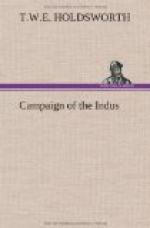At this place, Alexander first came upon the scene of the campaign referred to in the following letters. Here he meditated the invasion of India, intending to march to the mouth of the Ganges; but the conquest of that country was destined for a nation almost unknown in the days of Alexander, and lying far more remote from it than Greece; and, until the campaign of 1839 drew our armies to the western side of the Indus, the Sutlej was alike the boundary of Alexander’s conquests to the east, as of those of England towards the west.
Alexander having prepared his army for this expedition, moved towards the Indus, taking many strong places on his march. Having crossed that river, the king of the country offered no resistance, but became the ally of Alexander, who expected to have found Porus, whose kingdom was on the other side of the Hydaspes, equally ready to submit. But it required the utmost skill of Alexander to cross the river, which he effected, and conquered Porus, after a most severe struggle, with the loss of his renowned charger, Bucephalus, and he was so pleased at the magnanimity of Porus that he not only gave him back his kingdom, but added several small states to it, making him a sincere ally. Alexander then continued his march towards the east, conquering all who opposed him, until he reached the banks of the Hyphasis (Sutlej), which he was about to cross, when his progress was arrested by murmurs and tumults in his camp. His soldiers declared their determination not to extend his conquests, and entreated him to return. He then marched back to the Acesines, gave the whole country as far as the Hyphasis to Porus, and thus made him ruler of the Punjab. Alexander encamped near the Acesines until the month of October, when the fleet which he built, consisting of 800 galleys and boats, being ready, he embarked his army and proceeded towards the Indus; but before he reached that river he came to two countries possessed by warriors who united their armies to oppose his progress. After beating them in many engagements, Alexander attacked the city of the Oxydracae, into which the greater part of those armies had retired. Here his rash valour had nearly terminated his career: he was severely wounded in the side by an arrow, from the effects of which he was with difficulty restored to health. He then descended the river, a portion of his army marching on its banks, conquering every nation that opposed him. About the month of July he reached




